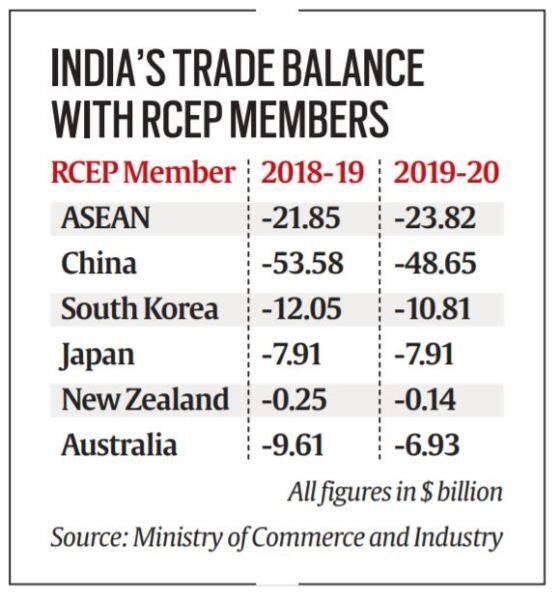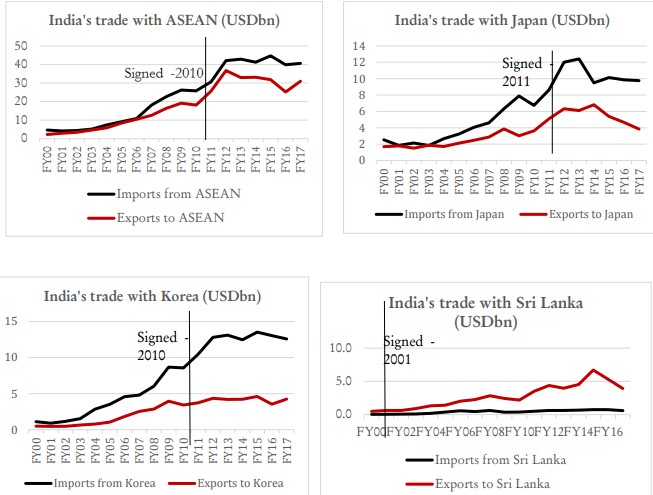Regional Comprehensive Economic Partnership (RCEP), covers over 2.2 billion people and accounts for 30 per cent of the world’s economy. India decided to hold off on signing the agreement. It comprises of ten South East Asian countries viz., Brunei, Cambodia, Indonesia, Laos, Malaysia, Myanmar, the Philippines, Singapore, Thailand, and Vietnam plus China, Japan, South Korea, Australia, New Zealand, and India.
Prime Minister Narendra Modi said: “The present form of the RCEP Agreement does not fully reflect the basic spirit and the agreed guiding principles of RCEP. It also does not address satisfactorily India’s outstanding issues and concerns. In such a situation, it is not possible for India to join the RCEP agreement.”
The RCEP aims to remove trade barriers, including tariffs and duties, among its 16 members for a seamless flow of goods and services. However, at a time when India is going through an economic slowdown, the signing of the pact could have put further strain on an already struggling economy. India’s concerns for protection for its domestic industries were not adequately answered leading to it pulling the plug. The manufacturing and farming industries had raised concerns about lack of trade protection when cheap imports from China would have flown into the country with even fewer barriers. India already runs a $50 billion trade deficit with China and RCEP would have stretched the chasm even wider.
“All India Kisan Sangharsh Coordination Committee (AIKSCC), is happy that good sense has prevailed on this government and its decision to barter away the lives and livelihoods of crores of farmers, workers and small businesses has been averted,” AIKSCC convenor VM Singh was quoted. The Swadeshi Jagran Manch (SJM), Co convenor Ashwani Mahajan said that the move was in favour of Indian economy. “We welcome the PM’s decisions and congratulate him for taking such a bold move that is in favour of the country and its economy.” Mahajan.

Major issues that were unresolved during RCEP negotiations were “inadequate” protections against surges in imports. It felt there could also be a possible circumvention of rules of origin the criteria used to determine the national source of a product in the absence of which some countries could dump their products by routing them through other countries that enjoyed lower tariffs.
a) India was unable to ensure countermeasures like an auto-trigger mechanism to raise tariffs on products when their imports crossed a certain threshold.
b) It also wanted RCEP to exclude most-favoured nation (MFN) obligations from the investment chapter, as it did not want to hand out, especially to countries with which it has border disputes, the benefits it was giving to strategic allies or for geopolitical reasons.
c) India felt the agreement would force it to extend benefits given to other countries for sensitive sectors like defence to all RCEP members.
d) RCEP also lacked clear assurance over market access issues in countries such as China and non-tariff barriers on Indian companies.
e) An internal assessment by the government has revealed that the growth in trade (CAGR) with partners over the last five financial years was a modest 7.1%. While “there has been growth rate in both imports from and exports to these FTA partners”, the “utilisation rate” of FTAs both for India and its partners has been “moderate” across sectors, according to this study, which covers pacts with Sri Lanka, Afghanistan, Thailand, Singapore, Japan, Bhutan, Nepal, Republic of Korea and Malaysia.
f) India has trade deficits with 11 of the 15 RCEP countries, and some experts feel that India has been unable to leverage its existing bilateral free trade agreements with several RCEP members to increase exports.

China Factor: RCEP was pushed by Beijing in 2012 in order to counter another FTA that was in the works at the time: The Trans-Pacific Partnership (TPP). The US-led TPP excluded China. However, in 2016 US President Donald Trump withdrew his country from the TPP. Since then, the RCEP has become a major tool for China to counter the US efforts to prevent trade with Beijing.
a) China is the key source of imports and is also the main export destination for most member nations, the deal is likely to put it in a better position to shape the region’s trade rules.
b) In the list of countries with which China has the highest trade surpluses, India now ranks second behind America. China’s surplus with the United States, of course, is massive. But as a percentage of total bilateral trade or as a percentage of national gross domestic product, India’s trade deficit with China is greater than America’s. India’s trade deficit with China in 2018 accounted for 2.2 percent of its GDP.
c) China’s unfair trade practices are systematically undermining Indian manufacturing and competitiveness, In fact, China’s annual trade surplus with India is significantly larger than India’s total defense spending, underscoring the extent to which India is underwriting Chinese hostility.
d) India already has free trade agreements with 12 of the other 15 RCEP participating countries, and is negotiating an FTA with Australia. The main beneficiary of India’s entry into the RCEP would be Beijing, because it would effectively establish a China-India FTA via the back door.
e) Overall trade deficit with ASEAN, Korea and Japan doubled to USD 24bn in FY17 from USD 15bn in FY’11(signing of the respective FTAs) and USD 5bn in FY’06. Trade deficit with Korea grew from USD 5bn in FY’10 to USD 8bn now. With Japan, the deficit grew from USD 3bn in FY10 to USD 6bn currently and the ASEAN deficit doubled to USD 10bn from USD 75bn in FY11.
At last one can say that as put by External Affairs Minister S. Jaishankar “In the name of openness, we have allowed subsidized products and unfair production advantages from abroad to prevail. And all the while, this was justified by the mantra of an open and globalised economy.” India had made its “choice” given the damaging consequences of previous free trade agreements, that had led to trade deficits, manufacturing cuts, job losses and to “becoming over-dependent on imports.”
India has actively pursued FTAs with several major trading partners in the past without benefitting much. According to the Asian Development Bank, the utilisation rate of India’s FTAs varies between 5% and 25%, which is one of the lowest in Asia. Moreover, exports to FTA partner countries and non-partner countries have grown at the same pace. Complex rules of origin criteria, lack of information on FTAs, higher compliance costs and administrative delays dissuade exporters from using preferential routes. The compliance cost of availing benefits under these FTAs is so high that exporters prefer using the normal route. India has actively pursued FTAs with several major trading partners in the past without benefitting much.
India has FTAs with the Association of Southeast Asian Nations (ASEAN), Japan, South Korea, and three-fourths of the bilateral trade already happens with zero duty. India also has a small preferential trade agreement with China. India ranks higher than the U.S., Japan, and China in the trade openness ratio, the globally accepted measure. The ratio is the sum of all imports and exports as % of GDP of India (43) is more open than the United States (27), Japan (35), and China (38). So the Indian Government is right to Halt Joining RCEP until it feels it is comfortable after all India always believe in Globalization Liberalization Democracy and rules based Order.
(Author is a Political Analyst, Columnist, International Affairs and Korea Expert)
M.AM.PhiL/(PhD SNU South Korea)
